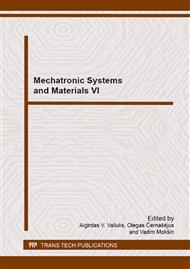[1]
K. Ullakko, J. K. Huang, C. Kantner, R.C. O´Handley, V.V. Kokorin, Large magnetic field induced strains in Ni2MnGa single crystals, Applied Physics Letters 69(13) (1996) 1966–(1968).
DOI: 10.1063/1.117637
Google Scholar
[2]
A. Jaaskalainen, I. Aaltio, I. Suorsa, J. Tellinen, K. Ullakko, Basic properties of magnetic shape memory actuators, in: 8th international conference ACTUATOR 2002, June 10–12, 2002, Bremen, Germany.
Google Scholar
[3]
N. Calchand, A. Hubert, Y.L. Gorrec, B. Maschke, From canonical Hamiltonian to port Hamiltonian modeling application to magnetic shape memory alloys actuators, in: 4th Annual Dynamic Systems and Control Conference, DSCC'11, Arlington, VA, United States.
DOI: 10.1115/dscc2011-6022
Google Scholar
[4]
S. Flaga, J. Pluta, B. Sapiński, Characterization of MSMA-based Pneumatic Valves Acta Monostatica Slovaca volume 16(1)(2011) 34–38.
Google Scholar
[5]
I. Suorsa, J. Tellinen, E. Pagounis, I . Aaltio, K. Ullakko, Applications of magnetic shape memory actuators, in: 8th international conference ACTUATOR 2002, June, 10–12, 2002, Bremen, Germany.
Google Scholar
[6]
B. Holz, D. Naso, H. Janocha, L. Riccardi, MSM actuators design rules and control strategies Advanced Engineering Materials 14(8) (2012) 668–681.
DOI: 10.1002/adem.201200045
Google Scholar
[7]
A. Hubert, J-Y. Gauthier, N. Calchand, Y. L. Gorrec, Magnetic shape memory alloys as smart materials for micro-positioning device, Advanced Electromagnetics, 1(2) (2012) 75–84.
DOI: 10.7716/aem.v1i2.10
Google Scholar
[8]
A. Raatz, B. Holz, K. Schluter, Principle design of actuators driven by magnetic shape memory alloys, Advanced Engineering Materials 14(3) (2012) 682–686.
DOI: 10.1002/adem.201200078
Google Scholar
[9]
A. Nespoli, E. Villa, H. Janocha, S. Pittaccio, S. Viscuso, The high potential of shape memory alloys in developing miniature mechanical devices: a review on shape memory alloy mini-actuators, Sensors and Actuators A: Physical 158(1) (2010).
DOI: 10.1016/j.sna.2009.12.020
Google Scholar
[10]
S. Flaga, I. Oprzędkiewicz, B. Sapiński, Characteristics of an experimental MSMA-based actuator, Solid State Phenomena 198 (2013) 283–288.
DOI: 10.4028/www.scientific.net/ssp.198.283
Google Scholar


